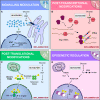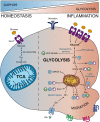Glycolysis - a key player in the inflammatory response
- PMID: 32255251
- PMCID: PMC7496292
- DOI: 10.1111/febs.15327
Glycolysis - a key player in the inflammatory response
Abstract
The inflammatory response involves the activation of several cell types to fight insults caused by a plethora of agents, and to maintain the tissue homoeostasis. On the one hand, cells involved in the pro-inflammatory response, such as inflammatory M1 macrophages, Th1 and Th17 lymphocytes or activated microglia, must rapidly provide energy to fuel inflammation, which is essentially accomplished by glycolysis and high lactate production. On the other hand, regulatory T cells or M2 macrophages, which are involved in immune regulation and resolution of inflammation, preferentially use fatty acid oxidation through the TCA cycle as a main source for energy production. Here, we discuss the impact of glycolytic metabolism at the different steps of the inflammatory response. Finally, we review a wide variety of molecular mechanisms which could explain the relationship between glycolytic metabolites and the pro-inflammatory phenotype, including signalling events, epigenetic remodelling, post-transcriptional regulation and post-translational modifications. Inflammatory processes are a common feature of many age-associated diseases, such as cardiovascular and neurodegenerative disorders. The finding that immunometabolism could be a master regulator of inflammation broadens the avenue for treating inflammation-related pathologies through the manipulation of the vascular and immune cell metabolism.
Keywords: ageing; immune cells; immunometabolism; inflammation; metabolites.
© 2020 The Authors. The FEBS Journal published by John Wiley & Sons Ltd on behalf of Federation of European Biochemical Societies.
Conflict of interest statement
The authors declare no conflict of interest.
Figures



Similar articles
-
The Metabolic Signature of Macrophage Responses.Front Immunol. 2019 Jul 3;10:1462. doi: 10.3389/fimmu.2019.01462. eCollection 2019. Front Immunol. 2019. PMID: 31333642 Free PMC article. Review.
-
Crosstalk between glucose metabolism, lactate production and immune response modulation.Cytokine Growth Factor Rev. 2022 Dec;68:81-92. doi: 10.1016/j.cytogfr.2022.11.001. Epub 2022 Nov 7. Cytokine Growth Factor Rev. 2022. PMID: 36376165 Review.
-
High-dose dexamethasone or all-trans-retinoic acid restores the balance of macrophages towards M2 in immune thrombocytopenia.J Thromb Haemost. 2017 Sep;15(9):1845-1858. doi: 10.1111/jth.13767. Epub 2017 Aug 5. J Thromb Haemost. 2017. PMID: 28682499
-
α-ketoglutarate orchestrates macrophage activation through metabolic and epigenetic reprogramming.Nat Immunol. 2017 Sep;18(9):985-994. doi: 10.1038/ni.3796. Epub 2017 Jul 17. Nat Immunol. 2017. PMID: 28714978
-
Macrophage immunometabolism dysregulation and inflammatory disorders.Biomed Pharmacother. 2025 Jul;188:118142. doi: 10.1016/j.biopha.2025.118142. Epub 2025 May 15. Biomed Pharmacother. 2025. PMID: 40378771 Review.
Cited by
-
Bioenergetic and Inflammatory Alterations in Regressed and Non-Regressed Patients with Autism Spectrum Disorder.Int J Mol Sci. 2024 Jul 27;25(15):8211. doi: 10.3390/ijms25158211. Int J Mol Sci. 2024. PMID: 39125780 Free PMC article.
-
The Hepatokine RBP4 Links Metabolic Diseases to Articular Inflammation.Antioxidants (Basel). 2024 Jan 19;13(1):124. doi: 10.3390/antiox13010124. Antioxidants (Basel). 2024. PMID: 38275649 Free PMC article.
-
miR-21 antagonism reprograms macrophage metabolism and abrogates chronic allograft vasculopathy.Am J Transplant. 2021 Oct;21(10):3280-3295. doi: 10.1111/ajt.16581. Epub 2021 May 3. Am J Transplant. 2021. PMID: 33764625 Free PMC article.
-
Single-Cell Profiling Indicates a Proinflammatory Role of Meningeal Ectopic Lymphoid Tissue in Experimental Autoimmune Encephalomyelitis.Neurol Neuroimmunol Neuroinflamm. 2024 Jan;11(1):e200185. doi: 10.1212/NXI.0000000000200185. Epub 2023 Dec 15. Neurol Neuroimmunol Neuroinflamm. 2024. PMID: 38100739 Free PMC article.
-
PDIA2 Bridges Endoplasmic Reticulum Stress and Metabolic Reprogramming During Malignant Transformation of Chronic Colitis.Front Oncol. 2022 Jul 4;12:836087. doi: 10.3389/fonc.2022.836087. eCollection 2022. Front Oncol. 2022. PMID: 35860571 Free PMC article.
References
Publication types
MeSH terms
LinkOut - more resources
Full Text Sources
Other Literature Sources

